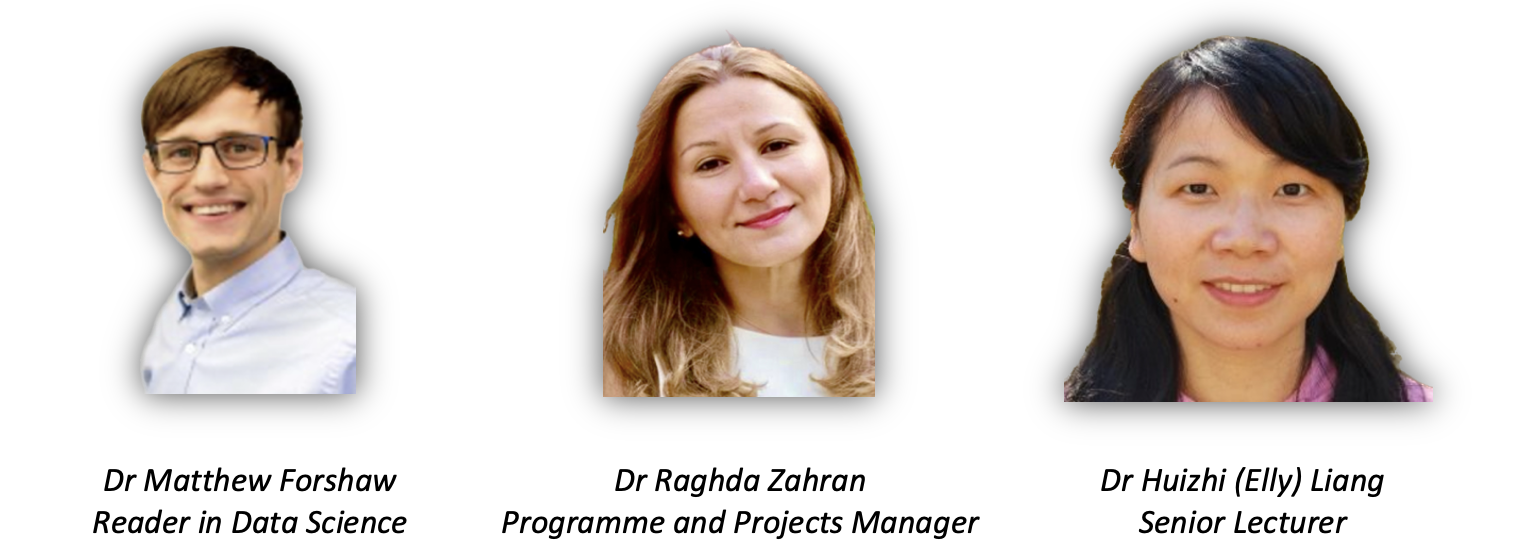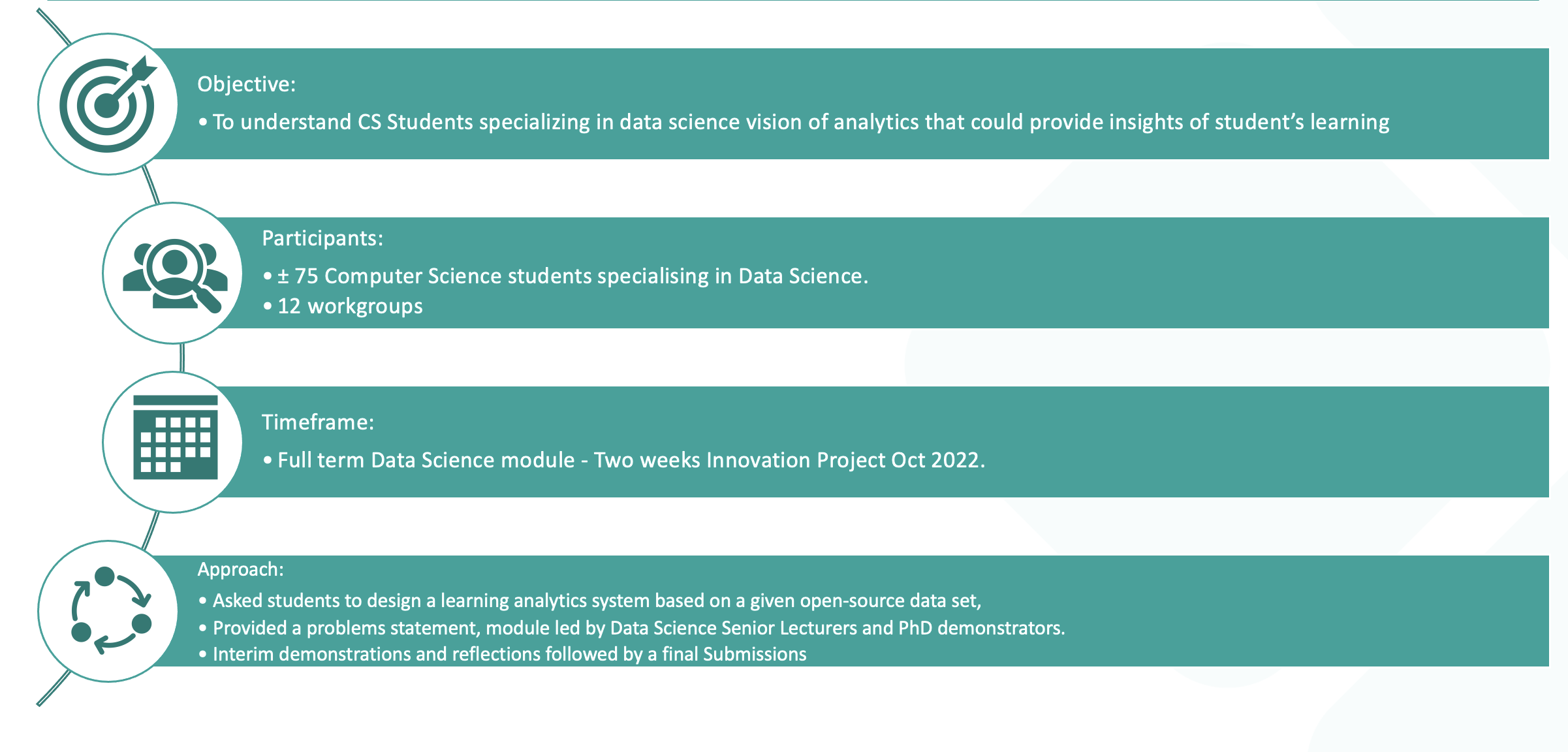Raghda Zahran (Programme and Projects Manager)
Project Management Office
NUIT
What did you do?
I worked with Data Science module leaders and PhD student demonstrators in the School of Computing to engage postgraduate students taking an Innovation Project.
This work aims to develop an understanding of Learning Analytics from Newcastle University students’ perspectives and to allow students to develop technologies relevant to their lived experiences and custom solutions tailored to their specific learning needs within the University context.
Who is involved?

Dr Raghda Zahran, Dr Matthew Forshaw, Dr Huizhi (Elly) Liang, PhD demonstrators Ben Jaeger, Iain Dixon, Marco Lewis, and Osman Akbulut.
Raghda, I oversee the development of learning analytics initiatives at Newcastle University, engaging senior executives, academics, and students. My roles as a Programme and Project Manager in the Project Management Office (PMO) and previously as a Technology Enhanced Learning Adviser in the Learning and Teaching Development (LTDS) Service have enabled me to apply various approaches to deliver successful project learning, teaching and engagement within and outside the University. I support students in applying their knowledge to real-world problems.
Matthew is a Reader in Data Science in the School of Computing, with extensive experience leading the Data Science Innovation module for several iterations and cohorts. Dr Forshaw has been an active member of the Newcastle University Learning Analytics Task and Finish Group, contributing to developing Learning Analytics initiatives at the University. He also supervised the mapping of Learning Analytics within the higher education sector in the United Kingdom, including engagement with comparator institutions. His expertise in Data Science and Learning Analytics has significantly contributed to developing innovative approaches to teaching and learning.
Huizhi (Elly) is a Senior Lecturer in Computing Science in the School of Computing, with extensive experience leading the Innovation Project module for 75 student cohorts and demonstrators for the Oct 2022 cohort. Her expertise in computing science and project management has been instrumental in guiding students through the development of innovative projects that address real-world problems.
How did you do it?
The Innovation Project module is designed to run for one academic term, during which students are supported to continue developing their skills in applied Data Science. They work collaboratively to address a real-world problem to solve and supported autonomy to select and use tools and techniques to help them design and develop their proposed technologies.
In a previous semester, I collaborated with the module leaders to offer Learning Analytics as a primary problem for this module. Before the module, we conducted discovery sprints to understand students’ learning approaches better. This provided us with a solid foundation, to begin with. We’ve also engaged with colleagues to test essential analytics tools and get their perspectives. This module’s problem statement focused on designing analytics that could help improve students’ engagement and achievement.

As the problem owner, in line with the module leaders’ proposal, I tasked the students with solving a problem related to the University’s aim of providing students with their data to help them reflect and plan their learning and to enable colleagues to support them in their learning journey. However, we faced challenges due to the sensitivity of the data involved. To address this, Dr Huizhi Liang suggested using an open data set from the Open University that could account for data privacy concerns. The data set offered relevant data within the scope of the project.
Since the students worked in groups, they developed analytics from different perspectives. The module leaders invited me to an interim engagement session where I asked the students to present their work and probed them with questions to help them conceptualize their ideas.
In their development lifecycle, most students used the Cross Industry Standard Process for Data Mining (CRISP-DM) and various tools such as R, Python, Power BI, and version control with Git. They approached the data from descriptive, diagnostic/correlational, and predictive perspectives.
While exploring the data, the students sought to answer various questions concerning achievement and engagement. For example, students investigated the effect of submission trends on assessment scores and final exams, the timing of most course withdrawals, the trends of students’ grades over different course stages, and the impact of disability on access, interactions, and retention in one course. They also analysed the number of attempts and clicks per module and students’ pass and failure rates.

Sample Assessment Analytics Explored by Students
In addition, the students examined the relationship between engagement and academic performance. They explored whether early engagement led to better grades, the effect of engagement with the Virtual Learning Environment (VLE) clicks on final scores, and how to identify passing or failing students based on their interactions with the virtual learning environment. Students were encouraged to reflect on inclusion challenges and the potential limitations of a learner’s digital footprint. Finally, they investigated when students typically drop out of a course.
The key elements of the project
Why did you do it?
The decision to provide students with a project focused on Learning Analytics is highly relevant from two perspectives. Firstly, it directly aligns with the objectives of their Data Science Degree and Innovation Project module, allowing them to apply the skills and knowledge they have acquired in a real-world context.
Secondly, students bring to the project their own experiences as learners and their observations of teaching and support systems in both school and higher education contexts. This first-hand knowledge provides invaluable insights that can inform the development of practical Learning Analytics tools and strategies. By engaging with the project, students can deepen their understanding of learning and teaching processes and better appreciate the challenges in designing effective Learning Analytics solutions.
Overall, the project offers a unique opportunity for students to apply their Data Science skills meaningfully. The students’ use of CRISP-DM and various analytical tools allowed them to gain valuable insights into student achievement and engagement, which can inform future efforts to improve teaching and learning outcomes.
Does it work?
The idea of students as designers and developers of technology tools they use is powerful, as it encourages students to take an active role in their learning and empowers them to create tools tailored to their individual needs. This approach can also help students develop problem-solving, critical thinking, and collaboration skills.
One way to implement this approach is through project-based learning, where students can identify a problem or challenge they would like to solve and work collaboratively to design and create a technology tool that addresses that problem. This could involve coding languages like Python or JavaScript to create a web application or hardware like microcontrollers to build a physical device.
Another approach is to involve students in the design of existing technology tools. For example, educators can invite students to participate in focus groups or usability testing to provide feedback on the design and functionality of educational apps or software. This can help students develop a deeper understanding of how technology is created and how it can be used to support learning.
By involving students in designing and developing Learning Analytics solutions within their learning contexts, we can benefit from their specialization in Data Science. This approach also allows us to gain insights into students’ perspectives on Learning Analytics through their involvement in the design process.
Including students in designing analytics that would be useful for their learning is critical, as this approach is crucial to the success and growth of the Learning Analytics field in higher education contexts. UX user-driven software design is known to yield value for the end user, and involving students in the design and development process can help to ensure that the resulting analytics are relevant and effective for their needs.
Upskilling students in Data Science and engaging them in a problem they are experiencing while embedding them in the middle of their learning journey provides a solid foundation for experiential and relevant development of Learning Analytics for both the students themselves and their wider student community. By nurturing the skills and expertise of the next generation of data scientists and Learning Analytics professionals, we can support the ongoing development of this exciting and rapidly evolving field.
Student Reflection
“I have acquired a wealth of practical knowledge and skills in the CSC 8633 “Data Science Group Project” module. Through project-based learning, I gained insights into the real-life applications of data science. First and foremost, this course provided us with actual data about online courses, which added authenticity to our learning experience. Unlike artificially cleansed data, the dataset contained a significant amount of noise, presenting us with the challenge of exploring and extracting meaningful insights. Moreover, the module emphasized collaborative teamwork, allowing us to work in groups of members from different countries. This realistic environment enabled us to adapt to future teamwork dynamics in our professional endeavours. Additionally, the instructor guided us on version control and collaborative practices using GitHub, equipping us with valuable project collaboration skills. Throughout the course, we encountered a dataset, collaborated as a team to define analysis objectives, and divided tasks to execute the project. We built pipelines, automated data processing, generated models, and presented analysis reports with valuable recommendations.” Junzhe
Does your case study develop the following student attributes from the Graduate Framework?
Yes, this work supports students to be:
- Socially Responsible
- Future Focused
- Resilient
- Critical Thinkers
- Creative, Innovative and Enterprising
- Digitally Capable
- Curious
- Collaborative
- Engaged
To learn more about our approach to Learning Analytics, you can check out the following resources:
“Engaging Data Science Students in the explorative design of Learning Analytics based on an open-source data set of interactions with VLE, library, and grades similar to NU Scope” – Presentation by Dr Matthew Forshaw and Dr Huizhi Elly Liang. Available at https://podcasts.ncl.ac.uk/learningandteaching/series-2/episode-028-learning-analytics/
“Learning Analytics Links with Our Institutional and Educational Strategies, Objectives, and Support Services” – Interviews with Professor Tom Ward, Dr Colin Campbell, Graeme Redshaw-Boxwell, and Dr Linsey Ferrie. Available at https://podcasts.ncl.ac.uk/learningandteaching/series-1/episode-024-learning-analytics-special/
